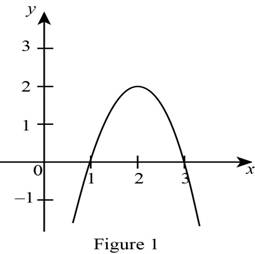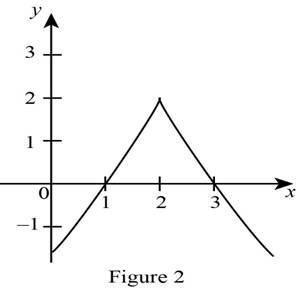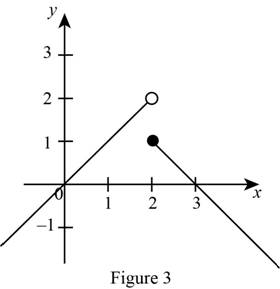
Concept explainers
(a) Sketch the graph of a function that has a
(b) Sketch the graph of a function that has a local maximum at 2 and is continuous but not differentiable at 2.
(c) Sketch the graph of a function that has a local maximum at 2 and is not continuous at 2.
a)
To sketch: The graph of a function thatsatisfies the conditions that the graph has local maximum at 2 and is differentiable at 2.
Explanation of Solution
Let the x be represented in the x-axis and the value of the function
Since an absolute maximum occurs at the point 2, choose the greatest point on x-axis. That is, consider the point on (2, 2).
The graph of a differentiable function must have a tangent at each point in its domain. it should be a smooth curve and cannot contain any break or cusps.
Since the graph is differentiable at 2, the derivative of
Draw the graph of the function f in such a way that it satisfies the given conditions as shown below in Figure 1.

From Figure 1, it is observed that the absolute maximum occurs at x = 2.
Also observe that the graph of the function is continuous and differentiable at x = 2.
b)
To sketch: The graph of a function that satisfies the conditions that the graph has local maximum at 2 and it is continuous but not differentiable at 2.
Explanation of Solution
Let the x be represented in the x-axis and the value of the function
Since the local maximum occurs at the point 2, choose the point 2 at any open interval of a domain. That is, consider the point on (2, 2).
Since the graph is not differentiable at 2 the derivative of
Draw the graph of the function f in such a way that it satisfies the given conditions as shown below in Figure 2.

From Figure 2 observe that the local maximum occurs at x = 2. And the curve is continuous.
Also, observe that the graph not differentiable at x = 2.
c)
To sketch: The graph of a function that satisfies the conditions that the graph has local maximum at 2 and it is not continuous at 2.
Explanation of Solution
Let the x be represented in the x-axis and the value of the function
Since local maximum occurs at the point 2, choose the point 2 on the open interval of a domain. That is, consider the point on (2, 2).
A function is discontinuous at x = 2 if the graph of the function has break at that point.
Draw the graph of the function f in such a way that it satisfies the given conditions as shown below in Figure 3.

From Figure 3 observe that the local maximum occurs at x = 2 and the function is not continuous at x = 2.
Chapter 4 Solutions
Single Variable Calculus: Concepts and Contexts, Enhanced Edition
Additional Math Textbook Solutions
Advanced Mathematical Concepts: Precalculus with Applications, Student Edition
Precalculus: Mathematics for Calculus - 6th Edition
Calculus, Single Variable: Early Transcendentals (3rd Edition)
Calculus 2012 Student Edition (by Finney/Demana/Waits/Kennedy)
University Calculus
University Calculus: Early Transcendentals (3rd Edition)
 Calculus: Early TranscendentalsCalculusISBN:9781285741550Author:James StewartPublisher:Cengage Learning
Calculus: Early TranscendentalsCalculusISBN:9781285741550Author:James StewartPublisher:Cengage Learning Thomas' Calculus (14th Edition)CalculusISBN:9780134438986Author:Joel R. Hass, Christopher E. Heil, Maurice D. WeirPublisher:PEARSON
Thomas' Calculus (14th Edition)CalculusISBN:9780134438986Author:Joel R. Hass, Christopher E. Heil, Maurice D. WeirPublisher:PEARSON Calculus: Early Transcendentals (3rd Edition)CalculusISBN:9780134763644Author:William L. Briggs, Lyle Cochran, Bernard Gillett, Eric SchulzPublisher:PEARSON
Calculus: Early Transcendentals (3rd Edition)CalculusISBN:9780134763644Author:William L. Briggs, Lyle Cochran, Bernard Gillett, Eric SchulzPublisher:PEARSON Calculus: Early TranscendentalsCalculusISBN:9781319050740Author:Jon Rogawski, Colin Adams, Robert FranzosaPublisher:W. H. Freeman
Calculus: Early TranscendentalsCalculusISBN:9781319050740Author:Jon Rogawski, Colin Adams, Robert FranzosaPublisher:W. H. Freeman
 Calculus: Early Transcendental FunctionsCalculusISBN:9781337552516Author:Ron Larson, Bruce H. EdwardsPublisher:Cengage Learning
Calculus: Early Transcendental FunctionsCalculusISBN:9781337552516Author:Ron Larson, Bruce H. EdwardsPublisher:Cengage Learning





